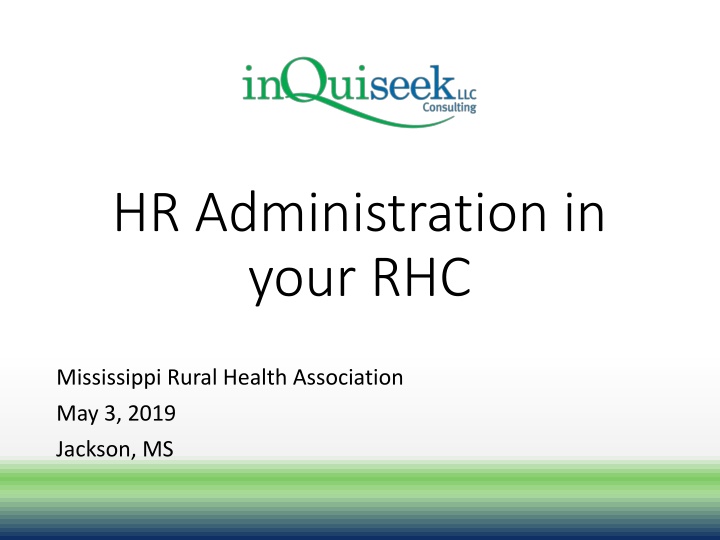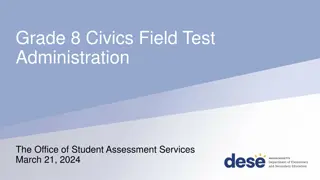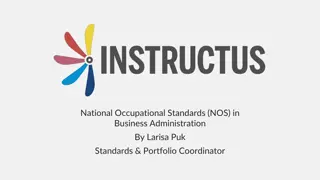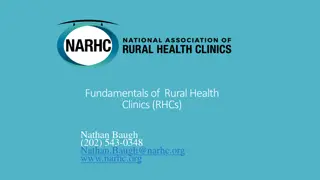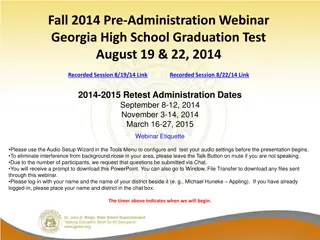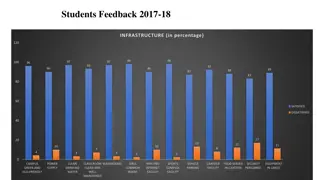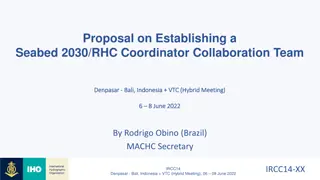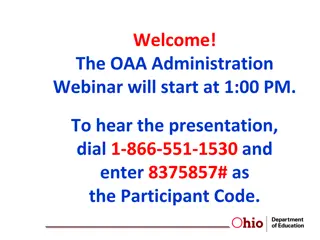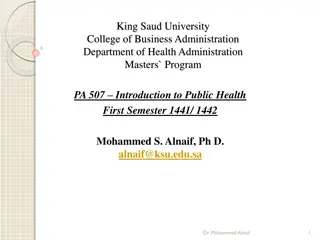HR Administration in your RHC
Learn about the differences and challenges in HR administration between Independent and Provider-based Rural Health Clinics. Explore the importance of hiring processes, dos and don'ts, and compliance issues related to HR recordkeeping requirements.
Download Presentation

Please find below an Image/Link to download the presentation.
The content on the website is provided AS IS for your information and personal use only. It may not be sold, licensed, or shared on other websites without obtaining consent from the author.If you encounter any issues during the download, it is possible that the publisher has removed the file from their server.
You are allowed to download the files provided on this website for personal or commercial use, subject to the condition that they are used lawfully. All files are the property of their respective owners.
The content on the website is provided AS IS for your information and personal use only. It may not be sold, licensed, or shared on other websites without obtaining consent from the author.
E N D
Presentation Transcript
HR Administration in your RHC Mississippi Rural Health Association May 3, 2019 Jackson, MS
Objectives The differences between HR Administration in an Independent RHC and a Provider-based RHC HR Challenges in both RHC and PBRHC Compliance Issues Related to HR Recordkeeping Requirements
INDEPENDENT RHC: Responsible for all HR functions at the Clinic Administrator or Manager Level. Wears lots of hats. May lack resources or support. May need HR consultant or attorney for big questions. May work with accountants, payroll services or other 3rd parties. PROVIDER-BASED: HR functions located at parent hospital. Clinic Manager needs basic understanding of HR administration. Must know corporate processes. Responsible for being source of information for RHC employees/staff.. Needs to collaborate with other departments. Hospital HR may not know RHC-specific requirements
The Importance of having an application process/form Same process for everyone Complete Information Gathered Signature of Applicant Authorization for Background Checks Acknowledgement of Felony Record (yes or no) Required in HR records reviewed by surveyor
Dos and Don'ts of Hiring Have a standard hiring process for all positions. Have applicants complete an application. Make sure that the job description is accurate and not a cookie cutter one. (Hospital nurse RHC nurse) Get authorization to check background information.
Dos and Don'ts of Hiring To post opening internally or not? Ask open-ended questions during the interview process. Don t ask questions which could be interpreted as discriminatory, biased or prejudiced in nature. Aim for A+ players
Dos and Don'ts of Hiring Look at skills and accomplishments not just education & experience. Consider generational differences. Communicate your clinic s vision and mission clearly. Encourage dialog and interaction to prevent a one-sided interview process.
The most important question: Are the right people on our bus? 9
Employing or Contracting Providers
Employee or Contractor? Professionals such as doctors, dentists, veterinarians, lawyers, accountants, contractors, subcontractors, public stenographers, or auctioneers who are in an independent trade, business, or profession in which they offer their services to the general public are generally independent contractors. However, whether these people are independent contractors or employees depends on the facts in each case. The general rule is that an individual is an independent contractor if the payer has the right to control or direct only the result of the work and not what will be done and how it will be done. The earnings of a person who is working as an independent contractor are subject to Self-Employment Tax. https://www.irs.gov/businesses/small-businesses-self- employed/independent-contractor-defined https://www.irs.gov/businesses/small-businesses-self- employed/independent-contractor-self-employed-or-employee
RHC Modernization Act RHC Modernization Act S. B. 1037- Introduced by Senator Barraso and Senator Tina Smith last month Need more Senate co-sponsors Still need House Sponsor Will raise independent RHC cap to $100, incremental increase over time Will redefine lab services Will allow RHC to be both distance and originating site for telemedicine Will allow NP/PA to practice at the top of their license per state regulation Allows NP/PA to be contracted and not employed
RHC Modernization Bill Advocacy Page RHC Modernization Bill Advocacy Page https://www.web.narhc.org/narhc/RHC _Modernization_Act_Advocacy.asp Official Publication of Bill https://www.congress.gov/bill/116th- congress/senate-bill/1037
Laws and Regulations 491.4 Compliance with Federal, State and local laws. The rural health clinic or FQHC and its staff are in compliance with applicable Federal, State and local laws and regulations.
Laws and Regulations Equal Opportunity Employer Office of Civil Rights Non-discrimination Fair Labor Act OSHA FMLA >50 employees Worker s Compensation Benefits State Regulations Grant or Contract Regulations
Employee or Contractor? Professionals such as doctors, dentists, veterinarians, lawyers, accountants, contractors, subcontractors, public stenographers, or auctioneers who are in an independent trade, business, or profession in which they offer their services to the general public are generally independent contractors. However, whether these people are independent contractors or employees depends on the facts in each case. The general rule is that an individual is an independent contractor if the payer has the right to control or direct only the result of the work and not what will be done and how it will be done. The earnings of a person who is working as an independent contractor are subject to Self-Employment Tax. https://www.irs.gov/businesses/small-businesses-self- employed/independent-contractor-defined https://www.irs.gov/businesses/small-businesses-self- employed/independent-contractor-self-employed-or-employee
Laws and Regulations 491.4 Compliance with Federal, State and local laws. The rural health clinic or FQHC and its staff are in compliance with applicable Federal, State and local laws and regulations.
Laws and Regulations Equal Opportunity Employer Office of Civil Rights Non-discrimination Fair Labor Act OSHA FMLA >50 employees Worker s Compensation Benefits State Regulations Grant or Contract Regulations
Laws and Regulations 42 CFR 491 Staffing Requirements State Licensure Requirements State RHC Regulations, if applicable State Scope of Practice State Labor Laws Required Posters
Changes in Key Personnel Any change in ownership or physician(s) responsible for the clinic s medical direction requires prompt notice to the RO. Neither of these changes requires resurvey or recertification if the change can otherwise be adequately verified. Notice of any change in the physician(s) responsible for providing the clinic s medical direction should include evidence that the physician(s) is licensed to practice in the State. (SOM Appendix G) Determine if changes to the 855A Ownership/Managing Control sections are required. Determine if changes to the CMS-29 are required. Notify your SORH. . Update Rosters/Signage/ Job Descriptions/Contracts/Policies and Procedures/Agreements.
Links and Resources: US Department of Labor https://www.dol.gov/ Office of Civil Rights https://www.hhs.gov/ocr/ OSHA For Healthcare https://www.osha.gov/SLTC/healthcarefacilities/standar ds.html
RHC Federal Regulations RHC Federal Regulations 42 CFR 491 https://www.gpo.gov/fdsys/pkg/CFR-2011-title42-vol5/pdf/CFR- 2011-title42-vol5-part491.pdf CMS Policy Benefit Manual, Chapter 13 https://www.cms.gov/Regulations-and- Guidance/Guidance/Manuals/downloads/bp102c13.pdf CMS Claims Processing Manual, Chapter 9 https://www.cms.gov/Regulations-and- Guidance/Guidance/Manuals/downloads/clm104c09.pdf State Operations Manual, Appendix G https://www.cms.gov/Regulations-and- Guidance/Guidance/Manuals/downloads/som107ap_g_rhc.pdf 24
The Role of Written Policies and Employee Handbooks
Policies Policies Written Policies are intended to communicate broad statements of compliance and intention. Use written policies for information that will largely remain static and demonstrates overall compliance measures. Do not create trivial policies. Have required RHC policies that pertain to certification standards. Use the employee handbook and supplemental training modules to communicate information which may change or need to be updated or redesigned. You can reference supplemental documents in your policy.
Time Time- -Keeping and record Keeping and record- -keeping keeping
Exempt or Non Exempt or Non- -exempt exempt Positions are classified as either exempt or non-exempt depending on the nature of the job tasks to be performed and if the employer is required to pay overtime. To be considered a bona fide executive, administrative, or professional employee under the Fair Labor Standards Act, workers must be compensated on a salary or fee basis at a rate of not less than $455 (week), $1,971.66 (monthly), or $23,660 (annually), excluding board, lodging, or other facilities. Some states have higher limits. Job status determines how or if overtime is paid as well as other benefits.
Overtime, On-Call and Other Tricky Details Overtime is defined as time worked over 40 hours a week. In healthcare workplaces, overtime may also be calculated using the 8:80 rule for employees working fixed schedules over a 14 day period. An employee must agree to be paid under the 8:80 rule. All employees should be made aware of pay rate and period methodologies. Employers are not required to pay increased wages for weekends, after hours, or holidays although it is customary. Fact Sheet #54 The Health Care Industry and Calculating Overtime Pay https://www.dol.gov/whd/regs/compliance/whdfs54.pdf On-Call: You must compensate for on-call hours if the employee is precluded from other activities or is restricted while on-call.
Payroll Record Employee Legal Name, Address, DOB, SSN, Sex Base Salary/Rate of Pay/How Pay is calculated Job Title/Description Regular Work Week (Start/Stop) Straight Hours Worked Overtime Hours Worked Deductions/Withholdings Pay Period and Pay Date Fact Sheet #21: Recordkeeping Requirements under the Fair Labor Standards Act (FLSA) https://www.dol.gov/whd/regs/compliance/whdfs21.pdf
Record-Keeping: Employees For each employee: Completed Application Signed Job Description I-9 (securely stored) Payroll tax forms (W-4, state forms). Updated every year. HIPAA, Security & Privacy Acknowledgments Signed Standard of Conduct Signed Employee Handbook page Employee Health Information (securely stored) OIG Sanction Check (Annually or more frequently) Other required background checks Health screenings (TB/Hep B) Employee Health
Record-Keeping: Providers and Licensed Staff Completed Application/Contract Signed Job Description, if applicable Resume or CV Payroll forms, as applicable (W-9, W-4, state forms) HIPAA, Security & Privacy Acknowledgments Signed Standard of Conduct Signed Employee Handbook page Employee Health Information (securely stored) OIG Sanction Check Other required background checks Diplomas Certifications Licenses/DEA/State Pharmacy Licenses Complete Work History
OIG Excluded Party Database Checked PRIOR to hire; periodically thereafter. Check all alias, AKA, maiden, previous married names OIG Database Search https://exclusions.oig.hhs.gov/ Mississippi Excluded Party Search (MS only) https://medicaid.ms.gov/providers/provider- terminations/
OIG Search Tips Check all known names including aliases, maiden, former married names. If name results, then check by Social Security Number Screen shot the results Self-report hiring violations If you are using a background or screening service, make sure they understand your specific screening requirements. Check contractors using the SAM system Links: https://exclusions.oig.hhs.gov/Default.aspx https://www.sam.gov/SAM/pages/public/searchRecords/search.jsf
Record-Keeping: Confidentiality Safeguard employee files. Protect confidentiality. Store payroll information separately. Store employee health information separately. Store negative information separately. Peer review investigations, professional licensure concerns, patient safety or care issues should be included in quality files.
Record-Keeping: Training Document Employee Orientation Document Initial Training on: HIPAA/Privacy & Security, general and specifically for role Compliance/Standard of Conduct RHC Policies and Procedures Emergency Procedures (Fire, External, Medical Emergency) Use of PPE/Standard Precautions/Protocols Clinical Competency Check-off Lab testing/controls Procedures Specific Tasks
Record-Keeping: Training Annual Training on: HIPAA/Privacy & Security, general and specifically for role Compliance/Standard of Conduct RHC/Hospital Policies and Procedures Emergency Preparedness Training Emergency Preparedness Testing Clinical Competency Check-off Lab testing/controls Procedures Specific Tasks
What Surveyors Want Surveyors and Evaluators will want evidence of employee files and training records. If these records are maintained by your parent entity, make sure that you either have access to the needed documents via a shared drive or that you have duplicate records on-site at your RHC. Surveyors may differ on how and where records are maintained.
Performance Management Formal annual review = OLD SCHOOL Gen X ,Millennials, ,Gen Z require more frequent, real time feedback. Use open-ended questions to evaluate employee satisfaction and to identify potential areas of concern or improvement. Two-sided process or 360 If job responsibilities have changed, revise job description. If performance is unsatisfactory, have a defined method of putting employee on a PIP. Be clear on how salaries or wages will be effected by performance.
Terminations Know your state laws. Know compensation rules. Clearly define terms for immediate dismissal. Clearly define terms for PIPS or probation. Document all actions. Follow corporate or hospital protocols, if applicable. Act succinctly and objectively. Have paperwork ready. Secure IT and system access. Minimize disruption to clinic operations. Have a plan for reassigning tasks or work load. Notify hospital HR or attorney, if applicable. Be able to communicate any post-employment benefits to employee. Communicate changes to employees and staff.
Employee Grievances Have an employee grievance process. Inform employees of the processes. Document employee complaints and resulting actions. Take employee complaints seriously. Apply the investigative process uniformly. Use the process to identify opportunities for improved employee communication, training and the revision of processes. Take appropriate actions for complaints which when investigated indicate a breach in regulatory compliance.
Creating Co-Worker Harmony Get the right people on your bus. Create a team mentality. Educate on how each role is dependent on the other for success. All roles are valuable and critical to your RHC mission. Encourage collaboration, brainstorming, and team- building.. Discourage texting battles between employees. Incentivize the team for optimal success. Zero tolerance for gossip, negative talk.or schisms Serve as a mediator for minor employee conflict.
